Internet Gateway Device (IGD) Standardized Device Control Protocol is a protocol for mapping ports in network address translation (NAT) setups, supported by a certain number of NAT-enabled routers. It is a common communications protocol of automatically configuring port forwarding, and is part of an ISO/IEC Standard rather than an Internet Engineering Task Force standard.
Usage
Applications using peer-to-peer networks, multiplayer gaming, and remote assistance programs need a way to communicate through home and business gateways. Without IGD one has to manually configure the gateway to allow traffic through, a process which is error prone and time consuming. Universal Plug and Play (UPnP) comes with a solution for network address translation traversal.
IGD makes it easy to do the following:
- Learn the public (external) IP address
- Requesting for a new public IP address
- Enumerate existing port mappings
- Add and remove port mappings
- Assign lease times to mappings
The host can allow to seek for available devices on the network via SSDP which can be controlled then with the help of a network protocol as SOAP. A seek request is sent via HTTP and port 1900 to the multicast address 239.255.255.250:
M-SEARCH * HTTP/1.1 Host:239.255.255.250:1900 ST:urn:schemas-upnp-org:device:InternetGatewayDevice:1 Man:"ssdp:discover" MX:3
Security risks
With the help of scripting on a web page new risks and dangers can be also caused by the IGD protocol, assuming that the change of the configuration on the gateway device has been permitted. Thereby it would be possible to bring a computer or also a whole network under the control of foreign users what often occurs in criminal intention. Many DSL-Routers, as for example FRITZ!Box common in Europe, support this procedure, the change of the configuration must be mostly still released by the user specially via the web interface, provided that the access was protected to the device by means of a password.

